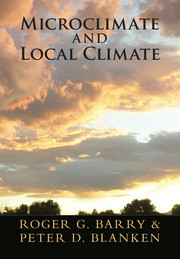Book contents
- Frontmatter
- Contents
- Preface
- Acknowledgments
- 1 Introduction
- Part I Controls of Microclimate
- 2 Microclimatic Elements
- 3 Methods of Observation and Instrumentation
- 4 Radiation
- 5 The Energy Balance
- 6 Monitoring Radiation, Energy, and Moisture Balance via Remote Sensing and Modeling with Land Surface Models
- 7 Microclimates of Different Vegetated Environments
- 8 Microclimates of Physical Systems
- 9 Bioclimatology
- Part II Local (Topo-)Climates
- Part III Environmental Change
- Problems
- Glossary
- Symbols
- System International (SI) Units and Conversions
- Index
- References
8 - Microclimates of Physical Systems
from Part I - Controls of Microclimate
Published online by Cambridge University Press: 05 May 2016
- Frontmatter
- Contents
- Preface
- Acknowledgments
- 1 Introduction
- Part I Controls of Microclimate
- 2 Microclimatic Elements
- 3 Methods of Observation and Instrumentation
- 4 Radiation
- 5 The Energy Balance
- 6 Monitoring Radiation, Energy, and Moisture Balance via Remote Sensing and Modeling with Land Surface Models
- 7 Microclimates of Different Vegetated Environments
- 8 Microclimates of Physical Systems
- 9 Bioclimatology
- Part II Local (Topo-)Climates
- Part III Environmental Change
- Problems
- Glossary
- Symbols
- System International (SI) Units and Conversions
- Index
- References
Summary
This chapter continues the presentation of microclimatic conditions in different environments, here treating the physical systems of lakes, rivers, snow cover, mountains, and cities.
Lakes
Lakes account for about 3 percent of the Earth's land surface with an annual maximum of 3.8 percent based on AMSR-E data (J. Kimball, p.c. 2011). Verpoorter et al. (2014) use imagery from the Enhanced Thematic Mapper Plus (ETM+) sensor on board the Landsat 7 satellite collected in year 2000 ± 3 years. For all lakes >0.002 km2, they estimate ~117 million lakes with a combined surface area of about 5 × 106 km2, which is 3.7 percent of the Earth's non-glaciated land area.
The largest in terms of surface area is Lake Superior at 82,400 km2 followed by Lake Victoria in East Africa at 69,500 km2. The deepest (>1600 m) is Lake Baikal in southern Siberia, which contains 20 percent of the world's freshwater. In the central Mackenzie basin of western Canada, lakes occupy 37 percent of the land surface. Wetzel (2001) provides a comprehensive treatment of limnology – the study of lakes and river systems and their ecology.
Water is an excellent absorber of shortwave radiation (a low albedo of 0.06–0.10); however, the amount of shortwave radiation reflected and hence not absorbed in the water column is affected by the water clarity (turbidity) and the angle of incidence between the Sun's rays and the water surface (solar zenith angle; wind/waves).
In clear water blue and violet light penetrate farthest and red light is absorbed first. However, the opposite is observed in very turbid lakes, or where there is dense phytoplankton (Ganf, 1974). In Lake George, Uganda, red light (0.5–0.7 μm) representing 10 percent of the total surface light reaches a depth of 50 cm and only 1 percent reaches a depth of 90 cm. In Lake Windermere in the Lake District of northwest England, Pearsall and Ullyott (1934) measured the percentages of full daylight penetrating to 1.0 m and 4.3 m depths over a year. The values at the 1-m depth ranged from almost 47 percent in March to 21 percent in August and correspondingly, 6.7 percent in March and 1.5 percent in June at a depth of 4.3 m. The penetration is shown to depend on the abundance of phytoplankton in the surface layers.
- Type
- Chapter
- Information
- Microclimate and Local Climate , pp. 187 - 217Publisher: Cambridge University PressPrint publication year: 2016
References
- 2
- Cited by



